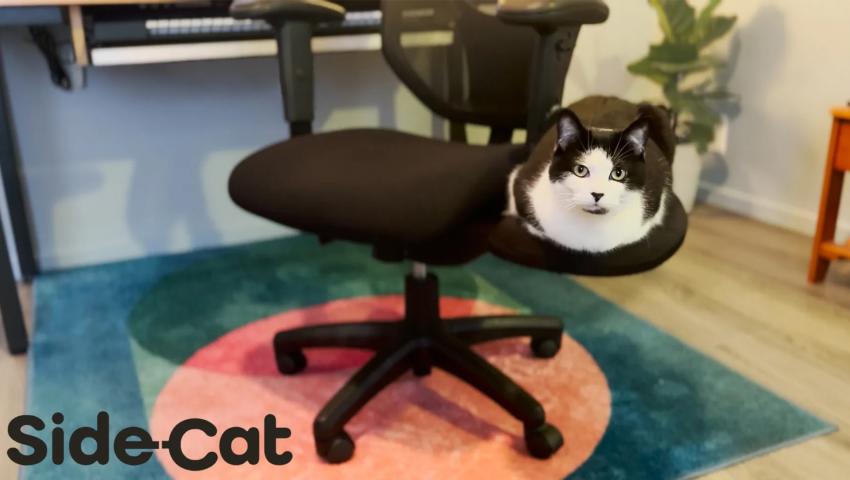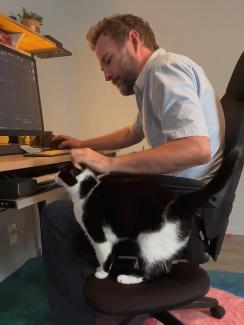
UK Innovate's Launch Blue Highlights SAVS' Paul Rodgers in Tech Showcase
Launch Blue, under the Office of Technology Commercialization in UK Innovate, supports promising technology startup founders and university innovators in Kentucky and beyond. Launch Blue is creating Tech Showcases to highlight Launch Blue innovators, founders and teams. Paul Rodgers is one of the UK Innovators that has been spotlighted.
Tech Showcase by Lauren Balla, from Launch Blue's website.
Amid the COVID-19 pandemic, many people transitioned from working in an office to working at home. For many of these people, this meant more time with their families and even their pets. For Paul Rodgers, working from home meant more time with Jojo, his adorable, keyboard-walking cat. Although he enjoyed spending more time with Jojo, her curiosity made Rodgers' job more difficult, not having enough space for himself and Jojo at the same time.
This problem sparked an idea for Rodgers, he was going to scour the internet for a cat seat attachment for his office chair. He searched for hours and could not find the product he was looking for, so he decided to create it himself. The pet furniture industry skyrocketed amid the pandemic, with the percentage of pet owners in the U.S. growing 10 percent in 2020. With the increase in homes with pets, the demand for pet furniture grew.
According to the American Pet Products Association, Americans went from spending $103.6 billion on pet furniture in 2020 to $123.6 billion in 2021. This meant an expanding market for pet furniture in the U.S. When Rodgers was spending hours searching online for cat furniture, functionality and appearance are key factors in determining whether he is going to purchase a product for Jojo.
“That's part of the reason why I wanted to make this is because I think most cat furniture is really ugly,” Rodgers said.“I bought a cat tower because that's really all that exists…and I got it in here and I just couldn't handle looking at it. So I had to take it down and return it because I just hated it so much.” Rodgers doesn’t want his cat furniture to disrupt the look of his space, and he doesn’t want this for any other cat owners either. On top of being visually pleasing to look at, Rodgers began designing his own cat furniture considering both function and aesthetics
“The novelty of it could be exciting for people to think about how to continue developing something that has a lot of possibilities for accessories,” Rodgers explained. “For example, seat covers, different attachments that are different shapes and sizes.” In his day job, Rodgers is a Senior Lecturer at the University of Kentucky’s College of Fine Arts. He is skilled in design, recently working in animation and motion design, which has helped him with his invention.
"The novelty of it could be exciting for people to think about how to continue developing something that has a lot of possibilities for accessories." - Paul Rodgers
His original plan was to make his office chair attachment, which he has named the SideCat, for himself and close friends and family only. He didn’t think to start a business or get a patent until his brother, who is a vice president at a pet insurance company, advised him to, seeing the potential impact of Rodgers’ creation. His brother is not the only one who saw this potential. Rodgers has been fairly active on his TikTok account @sidecat_hq, showcasing his invention to millions of people who are anxiously awaiting to buy their own SideCat.
Getting started was tough for the new entrepreneur, but once he started working with UK’s Office of Technology Commercialization and specifically Liz Knapp, his pathway forward became more clear. He completed Launch Blue’s UAccel Program, working closely with Knapp, which gave him the confidence and opportunity to make his invention into something that other cat owners could own and love as well.
Rodgers launched a Kickstarter campaign for the SideCat with a goal of $5,000. He surpassed his goal tremendously, garnering over $21,000. Rodgers’ audience is certainly ecstatic for his one-of-a-kind invention. He plans to release the SideCat in November, with over 200 people who have already pre-ordered their very own. Those interested in SideCat can stay up to date by visiting critterfitters.com and following the journey on social media.
Launch Blue nurtures promising startup founders and university innovators through intensive accelerator and incubator programs. Its funding partners are the University of Kentucky: Office of Technology Commercialization, KY Innovation, the U.S. Economic Development Administration, and the National Science Foundation.

Paul Rodgers and JoJo
